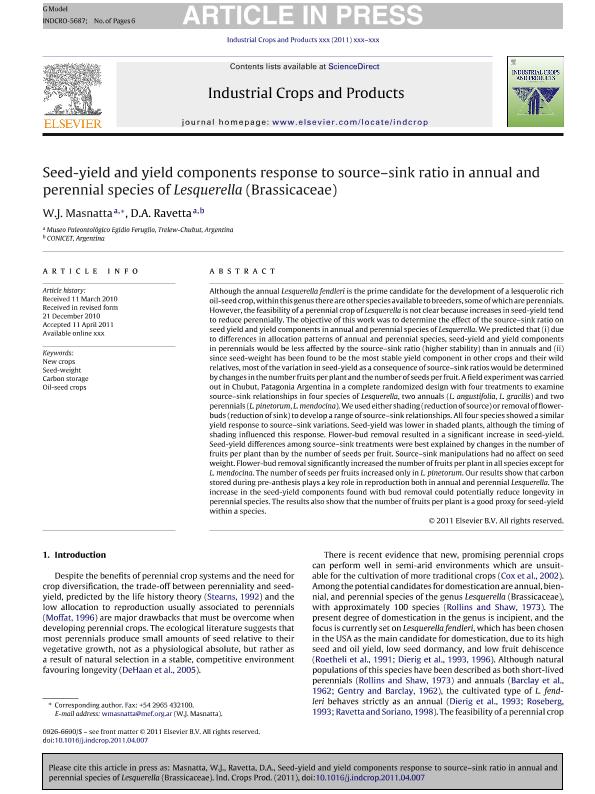Artículo
Seed-yield and yield components response to source-sink ratio in annual and perennial species of Lesquerella (Brassicaceae)
Fecha de publicación:
05/2011
Editorial:
Elsevier Science
Revista:
Industrial Crops and Products
ISSN:
0926-6690
Idioma:
Inglés
Tipo de recurso:
Artículo publicado
Clasificación temática:
Resumen
Although the annual Lesquerella fendleri is the prime candidate for the development of a lesquerolic rich oil-seed crop, within this genus there are other species available to breeders, some of which are perennials. However, the feasibility of a perennial crop of Lesquerella is not clear because increases in seed-yield tend to reduce perennially. The objective of this work was to determine the effect of the source-sink ratio on seed yield and yield components in annual and perennial species of Lesquerella. We predicted that (i) due to differences in allocation patterns of annual and perennial species, seed-yield and yield components in perennials would be less affected by the source-sink ratio (higher stability) than in annuals and (ii) since seed-weight has been found to be the most stable yield component in other crops and their wild relatives, most of the variation in seed-yield as a consequence of source-sink ratios would be determined by changes in the number fruits per plant and the number of seeds per fruit. A field experiment was carried out in Chubut, Patagonia Argentina in a complete randomized design with four treatments to examine source-sink relationships in four species of Lesquerella, two annuals (L. angustifolia, L. gracilis) and two perennials (L. pinetorum, L. mendocina). We used either shading (reduction of source) or removal of flower-buds (reduction of sink) to develop a range of source-sink relationships. All four species showed a similar yield response to source-sink variations. Seed-yield was lower in shaded plants, although the timing of shading influenced this response. Flower-bud removal resulted in a significant increase in seed-yield. Seed-yield differences among source-sink treatments were best explained by changes in the number of fruits per plant than by the number of seeds per fruit. Source-sink manipulations had no affect on seed weight. Flower-bud removal significantly increased the number of fruits per plant in all species except for L. mendocina. The number of seeds per fruits increased only in L. pinetorum. Our results show that carbon stored during pre-anthesis plays a key role in reproduction both in annual and perennial Lesquerella. The increase in the seed-yield components found with bud removal could potentially reduce longevity in perennial species. The results also show that the number of fruits per plant is a good proxy for seed-yield within a species.
Palabras clave:
CARBON STORAGE
,
NEW CROPS
,
OIL-SEED CROPS
,
SEED-WEIGHT
Archivos asociados
Licencia
Identificadores
Colecciones
Articulos(SEDE CENTRAL)
Articulos de SEDE CENTRAL
Articulos de SEDE CENTRAL
Citación
Masnatta, Wanda Jimena; Ravetta, Damián Andrés; Seed-yield and yield components response to source-sink ratio in annual and perennial species of Lesquerella (Brassicaceae); Elsevier Science; Industrial Crops and Products; 34; 2; 5-2011; 1393-1398
Compartir
Altmétricas




